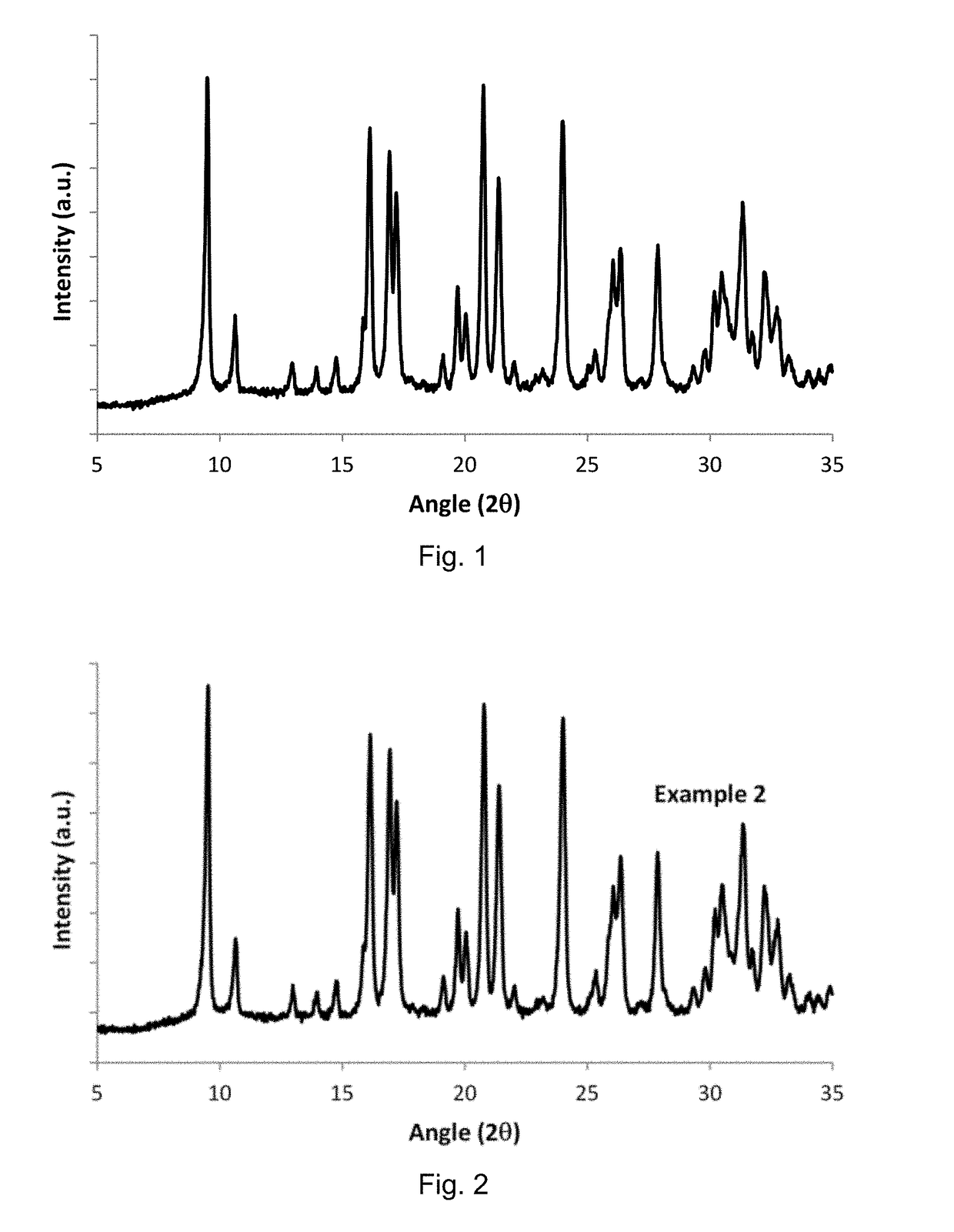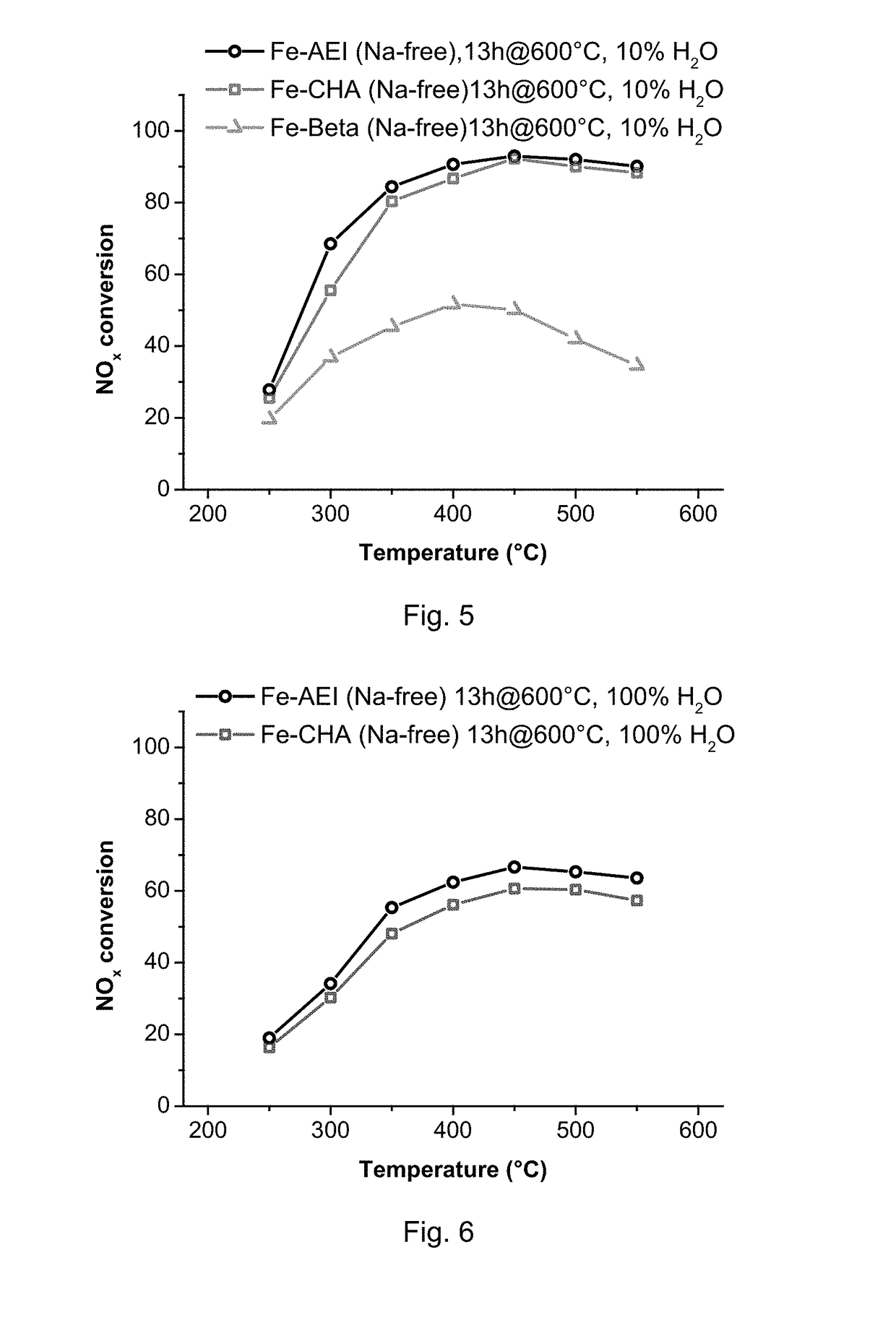Method for the Direct Synthesis of Iron-Containing AEI-Zeolite Catalyst
a technology of aei-zeolite and aei-zeolite, which is applied in the direction of catalyst activation/preparation, molecular sieve catalysts, inorganic chemistry, etc., can solve the problems of catalytically active material deactivation, zeolite catalyst deactivation, and insufficient hydrothermal stability of zeolite, so as to reduce the amount of alkali
- Summary
- Abstract
- Description
- Claims
- Application Information
AI Technical Summary
Benefits of technology
Problems solved by technology
Method used
Image
Examples
example 1
of AEI Zeolite (Na-Containing Material)
[0092]4.48 g of a 7.4% wt aqueous solution of N,N-dimethyl-3,5-dimethylpiperidinium hydroxide was mixed with 0.34 g of a 20% wt aqueous solution of sodium hydroxide (NaOH granulated, Scharlab). The mixture was maintained under stirring 10 minutes for homogenization. Afterwards, 0.386 g of FAU zeolite (FAU, Zeolyst CBV-720 with SiO2 / Al2O3=21) was added in the synthesis mixture, and maintained under stirring the required time to evaporate the excess of water until achieving the desired gel concentration. The final gel composition was SiO2:0.047 Al2O3:0.4 DMDMP:0.2 NaOH:15 H2O. The resultant gel was charged into a stainless steel autoclave with a Teflon liner. The crystallization was then conducted at 135° C. for 7 days under static conditions. The solid product was filtered, washed with abundant amounts of water, dried at 100° C. and, finally, calcined in air at 550° C. for 4 h.
[0093]The solid was characterized by Powder X-ray Diffraction, obtain...
example 2
nthesis of the Fe-Containing AEI Structure (Na-Containing Material)
[0094]1.98 g of a 7.0% wt aqueous solution of N,N-dimethyl-3,5-dimethylpiperidinium hydroxide was mixed with 0.24 g of a 20% wt aqueous solution of sodium hydroxide (NaOH granulated, Scharlab). The mixture was maintained under stirring 10 minutes for homogenization. Afterwards, 0.303 g of FAU zeolite (FAU, Zeolyst CBV-720 with SiO2 / Al2O3=21) was added in the synthesis mixture. Finally, 0.11 g of a 20% wt aqueous solution of iron (III) nitrate [Fe(NO3)3, Sigma Aldrich, 98%] was added, and the synthesis mixture was maintained under stirring the required time to evaporate the excess of water until achieving the desired gel concentration. The final gel composition was SiO2:0.047 Al2O3:0.01 Fe:0.2 DMDMP:0.2 NaOH:15 H2O. The resultant gel was charged into a stainless steel autoclave with a Teflon liner. The crystallization was then conducted at 140° C. for 7 days under static conditions. The solid product was filtered, was...
example 3
of Fe-Containing Na-Free AEI Zeolite by Post-Synthetic Ion Exchange
[0095]The Na-containing AEI material from Example 1 was first exchanged with a 0.1 M solution of ammonium nitrate (NH4NO3, Fluka, 99 wt %) at 80° C. Then, 0.1 g of ammonium-exchanged AEI zeolite was dispersed in 10 ml of deionized water with pH adjusted to 3 using 0.1 M HNO3. The suspension was heated to 80° C. under nitrogen atmosphere, 0.0002 moles of FeSO4.7H2O was then added, and the resultant suspension maintained under stirring at 80° C. for 1 h. Finally, the sample was filtered, washed and calcined at 550° C. for 4 h. The final iron content in the sample was 0.9 wt % and the Na content was below 0.04% wt.
PUM
| Property | Measurement | Unit |
|---|---|---|
| temperature | aaaaa | aaaaa |
| crystallization temperature | aaaaa | aaaaa |
| temperatures | aaaaa | aaaaa |
Abstract
Description
Claims
Application Information
 Login to View More
Login to View More - R&D
- Intellectual Property
- Life Sciences
- Materials
- Tech Scout
- Unparalleled Data Quality
- Higher Quality Content
- 60% Fewer Hallucinations
Browse by: Latest US Patents, China's latest patents, Technical Efficacy Thesaurus, Application Domain, Technology Topic, Popular Technical Reports.
© 2025 PatSnap. All rights reserved.Legal|Privacy policy|Modern Slavery Act Transparency Statement|Sitemap|About US| Contact US: help@patsnap.com



